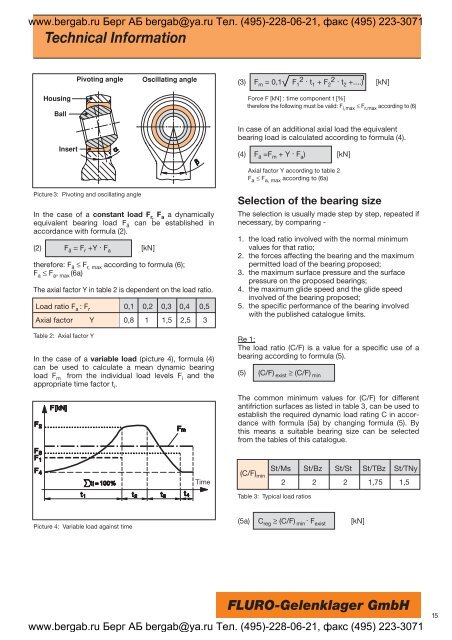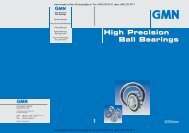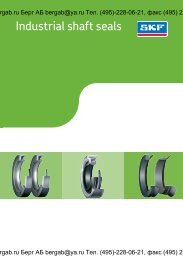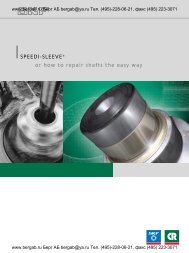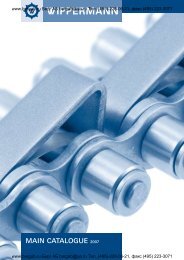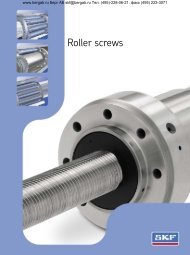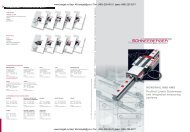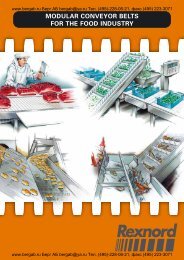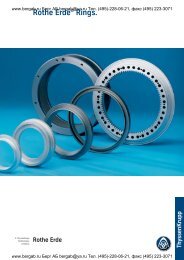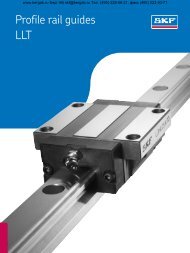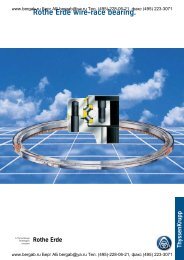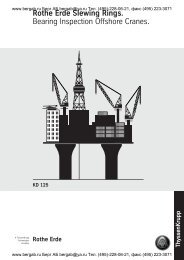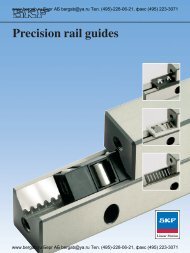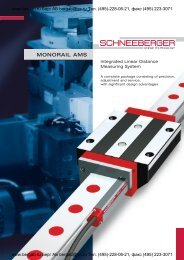FLURO-Gelenklager GmbH
FLURO-Gelenklager GmbH
FLURO-Gelenklager GmbH
Create successful ePaper yourself
Turn your PDF publications into a flip-book with our unique Google optimized e-Paper software.
www.bergab.ru Берг АБ bergab@ya.ru Тел. (495)-228-06-21, факс (495) 223-3071<br />
Technical Information<br />
Pivoting angle<br />
Oscillating angle<br />
(3) F m = 0,1 F 2.<br />
1 t1 + F 2.<br />
2 t2 +....) [kN]<br />
Housing<br />
Ball<br />
Insert<br />
Force F [kN] : time component t [%]<br />
therefore the following must be valid: F i,max ≤ F r,max according to (6)<br />
In case of an additional axial load the equivalent<br />
bearing load is calculated according to formula (4).<br />
(4) F ä =F m + Y . F a ) [kN]<br />
Axial factor Y according to table 2<br />
F a ≤ F a, max according to (6a)<br />
Picture 3: Pivoting and oscillating angle<br />
In the case of a constant load F r, F a a dynamically<br />
equivalent bearing load F ä can be established in<br />
accordance with formula (2).<br />
(2) F ä = F r +Y . F a [kN]<br />
therefore: F ä ≤ F r, max according to formula (6);<br />
F a ≤ F a , max (6a)<br />
The axial factor Y in table 2 is dependent on the load ratio.<br />
Load ratio F a : F r 0,1 0,2 0,3 0,4 0,5<br />
Axial factor Y 0,8 1 1,5 2,5 3<br />
Table 2: Axial factor Y<br />
In the case of a variable load (picture 4), formula (4)<br />
can be used to calculate a mean dynamic bearing<br />
load F m from the individual load levels F i and the<br />
appropriate time factor t i .<br />
Selection of the bearing size<br />
The selection is usually made step by step, repeated if<br />
necessary, by comparing -<br />
1. the load ratio involved with the normal minimum<br />
values for that ratio;<br />
2. the forces affecting the bearing and the maximum<br />
permitted load of the bearing proposed;<br />
3. the maximum surface pressure and the surface<br />
pressure on the proposed bearings;<br />
4. the maximum glide speed and the glide speed<br />
involved of the bearing proposed;<br />
5. the specific performance of the bearing involved<br />
with the published catalogue limits.<br />
Re 1:<br />
The load ratio (C/F) is a value for a specific use of a<br />
bearing according to formula (5).<br />
(5) (C/F) exist ≥ (C/F) min<br />
The common minimum values for (C/F) for different<br />
antifriction surfaces as listed in table 3, can be used to<br />
establish the required dynamic load rating C in accordance<br />
with formula (5a) by changing formula (5). By<br />
this means a suitable bearing size can be selected<br />
from the tables of this catalogue.<br />
Time<br />
(C/F) min<br />
St/Ms St/Bz St/St St/TBz St/TNy<br />
2 2 2 1,75 1,5<br />
Table 3: Typical load ratios<br />
Picture 4: Variable load against time<br />
(5a) C reg ≥ (C/F) min<br />
. Fexist [kN]<br />
<strong>FLURO</strong>-<strong>Gelenklager</strong> <strong>GmbH</strong><br />
www.bergab.ru Берг АБ bergab@ya.ru Тел. (495)-228-06-21, факс (495) 223-3071<br />
15


